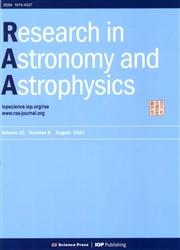Implications of the Stellar Mass Density of High-$z$ Massive Galaxies from JWST on Warm Dark Matter
IF 2.8
4区 物理与天体物理
Q3 ASTRONOMY & ASTROPHYSICS
引用次数: 4
Abstract
Abstract A significant excess of the stellar mass density at high redshift has been discovered from the early data release of James Webb Space Telescope ($\it{JWST}$), and it may require a high star formation efficiency. However, this will lead to large number density of ionizing photons in the epoch of reionization (EoR), so that the reionization history will be changed, which can arise tension with the current EoR observations. Warm dark matter (WDM), via the free streaming effect, can suppress the formation of small-scale structure as well as low-mass galaxies. This provides an effective way to decrease the ionizing photons when considering a large star formation efficiency in high-$z$ massive galaxies without altering the cosmic reionization history. On the other hand, the constraints on the properties of warm dark matter can be derived from the $\it JWST$ observations. In this work, we study WDM as a possible solution to reconcile the $\it JWST$ stellar mass density of high-$z$ massive galaxies and reionization history. {\color{red}We find that, the $\it JWST$ high-$z$ comoving cumulative stellar mass density alone has no significant preference for either CDM or WDM model. But using the observational data of other stellar mass density measurements and reionization history, we obtain that the WDM particle mass with $m_{\text{W}} = 0.51^{+0.22}_{-0.12}$ eV and star formation efficiency parameter $f_{*}^0>0.39$ in 2$\sigma$ confidence level can match both the $\it JWST$ high-$z$ comoving cumulative stellar mass density and the reionization history.来自JWST的高z大质量星系的恒星质量密度对热暗物质的影响
根据詹姆斯·韦伯太空望远镜(JWST)早期发布的数据,在高红移处发现了明显的恒星质量密度过剩,这可能需要很高的恒星形成效率。然而,这将导致再电离时期(EoR)的大量电离光子密度,从而改变再电离历史,从而与当前的EoR观测产生紧张关系。温暗物质(WDM)通过自由流效应可以抑制小尺度结构和低质量星系的形成。这为在不改变宇宙再电离历史的情况下降低高z质量星系中大恒星形成效率的电离光子提供了一种有效的方法。另一方面,热暗物质性质的约束可以从JWST的观测中推导出来。在这项工作中,我们研究了WDM作为一种可能的解决方案来调和高z质量星系的JWST质量密度和再电离历史。我们发现,单独的JWST$ $高$ $z$移动累积恒星质量密度对CDM或WDM模型都没有显著的偏好。但利用其他恒星质量密度测量和再电离历史的观测数据,我们得到了WDM粒子质量为$m_{\text{W}} = 0.51^{+0.22}_{-0.12}$ eV和恒星形成效率参数$f_{*}^0>0.39$在2$\sigma$置信水平下可以匹配$\it JWST$高$z$运动累积恒星质量密度和再电离历史。
本文章由计算机程序翻译,如有差异,请以英文原文为准。
求助全文
约1分钟内获得全文
求助全文
来源期刊

Research in Astronomy and Astrophysics
地学天文-天文与天体物理
CiteScore
3.20
自引率
16.70%
发文量
2599
审稿时长
6.0 months
期刊介绍:
Research in Astronomy and Astrophysics (RAA) is an international journal publishing original research papers and reviews across all branches of astronomy and astrophysics, with a particular interest in the following topics:
-large-scale structure of universe formation and evolution of galaxies-
high-energy and cataclysmic processes in astrophysics-
formation and evolution of stars-
astrogeodynamics-
solar magnetic activity and heliogeospace environments-
dynamics of celestial bodies in the solar system and artificial bodies-
space observation and exploration-
new astronomical techniques and methods
 求助内容:
求助内容: 应助结果提醒方式:
应助结果提醒方式:


